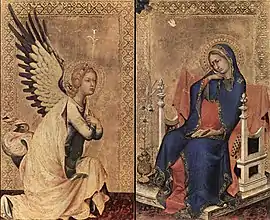Simone Martini
Simone Martini (c. 1284 – July 1344) was an Italian painter born in Siena. He was a major figure in the development of early Italian painting and greatly influenced the development of the International Gothic style.
Simone Martini | |
|---|---|
 Petrarch's Virgil (title page) (c. 1336) Illuminated manuscript, 29,5 x 20 cm Biblioteca Ambrosiana, Milan | |
| Born | Simone Martini c. 1284 |
| Died | July 1344 (aged 59–60) |
| Nationality | Italian |
| Education | Duccio di Buoninsegna |
| Known for | Painting, Fresco |
| Notable work | Annunciation with St. Margaret and St. Ansanus |
| Movement | International Gothic |
It is thought that Martini was a pupil of Duccio di Buoninsegna, the leading Sienese painter of his time. According to late Renaissance art biographer Giorgio Vasari, Simone was instead a pupil of Giotto di Bondone, with whom he went to Rome to paint at the Old St. Peter's Basilica, Giotto also executing a mosaic there. Martini's brother-in-law was the artist Lippo Memmi. Very little documentation of Simone's life survives, and many attributions are debated by art historians. According to E. H. Gombrich, he was a friend of Petrarch and had painted a portrait of Laura.
Biography
Simone was doubtlessly apprenticed from an early age, as would have been the normal practice. Among his first documented works is the Maestà of 1315 in the Palazzo Pubblico in Siena.[1] Lippo Memmi painted a similar Maestà for the Palazzo Comunale in San Gimignano shortly afterwards, an example of the enduring influence Simone's prototypes would have on other artists throughout the 14th century. Perpetuating the Sienese tradition, Simone's style contrasted with the sobriety and monumentality of Florentine art, and is noted for its soft, stylized, decorative features, sinuosity of line, and courtly elegance. Simone's art owes much to French manuscript illumination and ivory carving: examples of such art were brought to Siena in the fourteenth century by means of the Via Francigena, a main pilgrimage and trade route from Northern Europe to Rome.
Simone's other major works include the Saint Louis of Toulouse Crowning His Brother Robert of Anjou (1317, now Museo di Capodimonte, Naples); this work was painted during a stay in Naples at the request of the king. During this stay, putative pupils were his son Francesco, Gennaro di Cola, and Stefanone.[2][3]
Simone also painted the Saint Catherine of Alexandria Polyptych in Pisa (1319) and the Annunciation with St. Margaret and St. Ansanus at the Uffizi in Florence (1333), as well as frescoes in the San Martino Chapel[1] in the lower church of the Basilica of San Francesco d'Assisi. Francis Petrarch became a friend of Simone's while in Avignon, and two of Petrarch's sonnets (Canzoniere 96 and 130) make reference to a portrait of Laura de Noves that Simone supposedly painted for the poet (according to Vasari). A Christ Discovered in the Temple (1342) is in the collections of Liverpool's Walker Art Gallery.
Simone Martini died while in the service of the Papal court at Avignon in 1344.
Gallery

 Annunciation Diptych, 1333
Annunciation Diptych, 1333
 Virgin and Child with Saints (Boston Polyptych), c. 1321–25
Virgin and Child with Saints (Boston Polyptych), c. 1321–25 The Miracle of the Child Attacked and Rescued from the Blessed Agostino Novello Triptych, c. 1328
The Miracle of the Child Attacked and Rescued from the Blessed Agostino Novello Triptych, c. 1328 Christ Discovered in the Temple, 1342
Christ Discovered in the Temple, 1342 Maestà, 1315, Palazzo Pubblico, Siena
Maestà, 1315, Palazzo Pubblico, Siena_1315.jpg.webp) Detail of the Maesta
Detail of the Maesta
See also
Sources
- Vasari, Giorgio; translation by George Bull (1965). Lives of the Artists. Penguin Classics.
- Rossetti, William Michael (1911). . Encyclopædia Britannica. Vol. 17 (11th ed.). p. 801.
- Il costume antico e moderno, ovvero Storia del governo, della milizia, delle religion, delle arte, scienza ed usanze de tutti, volume 3, by Giulio Ferrario (1833) p. 72.
- Matteo Camera refers to him erroneously as Simone Memmi, conflating Martini and his pupil Lippo Memmi, in Elucubrazioni storico-diplomatiche su Giovanna I.a, regina di Napoli e Carlo III di Durazzo, Salerno (1889): page 139.
External links
- Herbermann, Charles, ed. (1913). . Catholic Encyclopedia. New York: Robert Appleton Company.
- Frescoes by Simone Martini in the Lower Basilica in Assisi
- Art of Simone Martini
- Simone Martini – Gothic Painter
- Simone Martini at the National Gallery of Art